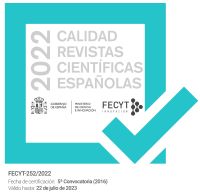Αιτια and Language: A Reformulation of Dionysian Causality in Jean-Luc Marion’s Phenomenology
DOI:
https://doi.org/10.5944/endoxa.52.2023.30066Keywords:
Jean-Luc Marion, Dionysius the Areopagite, Causality, LanguageAgencies:
Consejo Nacional de Investigaciones Científicas y Técnicas (CONICET), Universidad de Buenos Aires (UBA)Abstract
This paper aims to analyze Jean-Luc Marion’s reading of the concept of αἰτíα by Dionysius the Areopagite, emphasizing his interpretation of a causality conceived on a linguistic level. In the first place, we propose a general reading of the concept of causality in the neoplatonic tradition and its specific version in the work of Dionysius the Areopagite. Secondly, we examine Marion’s early readings of the Dionysian αἰτíα in light of the concept of praise (ὑμνεῖν), as can be found in her early article “Distance et Louange” (1971), and his work L’Idole et la distance (1977). Thirdly, we consider his interpretation of Dionysian work as a “pragmatic theology of absence” in De surcroît (2001). We argue that the Marionian interpretation of the Dionysian αἰτíα opens up
the possibility of non-metaphysical causality within phenomenology.
Downloads
References
MARION, Jean-Luc (1971). “Distance et Louange. Du concept de Réquisit (aitia) au status trinitaire du langage theologique selon Denys le Mystique”, Résurrection. Revue de doctrine crhétienne, Vol. 38, pp. 89-118.
— (1982). Dieu sans l´être, Paris: Fayard.
— (1989). Reduction et donation, Paris: PUF.
— (2001). De surcroît: études sur les phénomènes saturés, Paris: PUF.
— (2006). “Denys L’Aréopagite”. Le néant. Contribution à l’histoire du non-être dans la philosophie occidentale, Eds. Laurent, J/ Romano, C, Paris: Épiméthée, pp. 187-200.
— (2008). Au Lieu de Soi. L´approche de Saint Augustin, Paris: PUF.
— (2010). Certitudes négatives, Paris: Grasset.
— (2012). La rigueur des choses, Paris: Flammarion.
— (2013a). Étant donné. Essai d´une phénoménologie de la donation, Paris: PUF.
— (2013b). L´Idole et la distance. “Cinq études”, Paris: Grasset & Fasquelle.
— (2013c), “Saint Thomas d´Aquin et l´onto-théo-logie”. Dieu sans l´être, Paris: PUF, Quadrige, pp. 279-332.
— (2016). “Seeing, or Seeing Oneself Seen: Nicholas of Cusa´s Contribution in De visione dei”, Journal of Religion, Vol. 96, pp. 305-331.
PSEUDO-DIONYSIUS AREOPAGITA (1990). Corpus Dionysiacum I. De divinis nominibus. Hrsg. von Suchla B.R., Patristische Texte und Studien, 33, Berlin/New York: Walter de Gruyter.
— (1990). Corpus Dionysiacum II. De coelesti hierarchia. De ecclesiastica hierarchia. De mystica theologia. Epistulae. Hrsg. von Brennecke, C. & Mühlenberg, E. Patristischen Kommission, Berlin/Boston: Walter de Gruyter.
2 Complementaria
BASSAS VILLA, Javier (2009). “Écriture phénoménologique et théologique: Fonctions du «comme», «comme si» et «en tant que» chez Jean-Luc Marion”, Studia Phaenomenologica. Romanian Journal of Phenomenology, Special Issue, pp. 135-155.
BEIERWALTES, Werner (1977). Identität und Differenz zum Prinzip cusanischen Denkens, Düsseldorf: Westdeutscher Verlag.
BRUNNER, Fernand. (1997). “Le néoplatonisme au Moyen Âge”, Métaphysique d´Ibn Gabirol et de la tradition platonicienne, Aldershot: Brookfield, pp. 1-21.
CAPELLE-DUMONT, Philippe (2012). Filosofía y teología en el pensamiento de Martin Heidegger, Buenos Aires, FCE.
D´AMICO, Claudia (2007). “Introducción general”. Todo y nada de todo, Ed. Claudia D´Amico, Buenos Aires: Winograd, pp. 13-31.
DERRIDA, Jacques (1987). “Comment ne pas parler: Dénégations”. Psyché. Inventions de l'autre, Paris: Galilée, pp. 535-596.
DIONISIO AREOPAGITA. (2007). Los nombres divinos, Trad. y Notas, Pablo Cavallero, Buenos Aires: Losada.
— (2008). La jerarquía celestial/ La jerarquía eclesiástica/ La teología mística / Epístolas, Trad. y Notas, Pablo Cavallero, Buenos Aires: Losada.
FALQUE, Emmanuel (2013). “Après la metaphysique? Le «poids de la vie» selon Saint Augustin”. Après la métaphysique: saint Augustin?, Ed. Alain de Libera, Institut d'Etudes Médiévales, Paris: Vrin, pp. 111-128.
GONDEK, Hans-Dieter / TENGELYI, Lazlo (2011). Neue Phänomenologie in Frankreich, Berlin: Suhrkamp, pp. 29-40.
GONZÁLEZ RÍOS, José (2014). Metafísica de la Palabra. El problema del lenguaje en el pensamiento de Nicolás de Cusa, Buenos Aires: Biblos.
GSCHWANDTNER, Christina M (2005). “Praise—Pure and Personal? Jean-Luc Marion’s. Phenomenologies of Prayer”. The Phenomenology of Prayer, Eds. Benson, Bruce Ellice / Wirzba, Norman, New York: Fordham University Press, pp. 168-181.
HADOT, Pierre (1973). “L´être et L`étant dans le néoplatonism”. Études Néoplatoniciennes, Neuchatel: A la Baconnière, pp. 27-41.
HEIDEGGER, Martin (2003). “Der Ursprung des Kunstwerkes”, Holzwege (1935-1946), GA 5, Frankfurt am Main: Vittorio Klostermann, pp. 1-70.
— (2006). “Die onto-theo-logische Verfassung der Metaphysik”, en Identität und Differenz, GA 11, Frankfurt am Main: Vittorio Klostermann, pp. 51-80.
PIZZI, Matías Ignacio (2020). “La certeza negativa a la luz del vocablo cusano possest: aportes para un lenguaje de la saturación”, El fenómeno saturado. Reflexiones sobre la excedencia de la donación en la fenomenología de Jean-Luc Marion, Ed. Roggero, J. Buenos Aires: SB, pp. 191-200.
RANG, Bernhard (1990). Husserls Phänomenologie der materiellen Natur, Frankfurt am Main: Vittorio Klostermann.
ROGGERO, Jorge Luis (2018). Hermenéutica del amor. La fenomenología de la donación de Jean-Luc Marion en diálogo con la fenomenología del joven Heidegger, Buenos Aires, SB.
— (2018). “La filosofía última de J.-L. Marion”. Tópicos, Revista de Filosofía, Vol. 55, pp. 31-59.
TAORMINA, Daniela (2001). “Ὰνεκφοίτητος. L´immanenza del derivato nel principio”. Elenchos. Rivista di studi sul pensiero antico, Vol. I, pp. 121-132.
TROUILLARD, Jean (1977). “Les degres du ποιεῐν chez Proclos”. Bertier, J. / Brisson, L. / Combes, J. / Trouillard, J. Recherches sur la tradition platonicienne, (Platon, Aristote, Proclos, Damasciuis), Paris: Vrin, pp. 101-141.
Downloads
Published
How to Cite
Issue
Section
License

This work is licensed under a Creative Commons Attribution-NonCommercial-NoDerivatives 4.0 International License.








